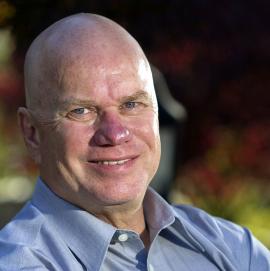 Silicon Valley veteran Maynard Webb has a knack for winding up at the center of things. The former COO of eBay and CEO of LiveOps is the chairman of Yahoo’s board, a director on the board of Salesforce.com, and just yesterday was nominated for election to the board of Visa.
Silicon Valley veteran Maynard Webb has a knack for winding up at the center of things. The former COO of eBay and CEO of LiveOps is the chairman of Yahoo’s board, a director on the board of Salesforce.com, and just yesterday was nominated for election to the board of Visa.
Webb isn’t content to live in the world of public companies, however. On the contrary, since 2010, Webb has been quietly building one of the most sprawling, and lowest-profile, investment networks in Silicon Valley. Called Webb Investment Network, the outfit, cofounded by Webb’s former LiveOps colleague Michael Neril, has now amassed a network of 90 “friends” who are invited into every deal that Webb is himself invited into — and he has backed 50 startups so far.
Webb calls giving these opportunities to invest alongside him “gifts.” I chatted with Webb yesterday to learn more. Our conversation has been edited for length.
In 2010, you already had plenty going on. Why formalize your investments with this kind of firm?
After I “retired” [in 2006] from eBay – eBay’s word for it – I was out running [the cloud-based call center service] LiveOps within just a couple of months. My wife asked how long I was going to do this and I said five years, thinking that would be a long time. But that five years came and went pretty quickly, and since I’d promised her that I wouldn’t operate companies any more [after LiveOps], as we started to come to late 2010, I thought, “Uh oh. What am I going to spend my time on?” I decided that I wanted to spend it helping entrepreneurs. Once I figured that out, I started looking at how to craft things in a way that I could provide help and also stay in touch with people I care about.
How does the network function? A founder who is raising $1 million allocates $500,000 to you, and you then invite your friends to invest up to half that amount if they want to?
That’s right, and that’s about our sweet spot, too. I knew there was no way I could adequately provide advice to all the companies I might want to invest in. So I just thought, I’ll give gifts to my friends. So every time we find a deal, we get twice as much as we want to invest, and I ask a few of my friends if they want to invest. They can opt in or out. But if they opt in, they have to [be helpful to the founders].
We thought we’d get 30 to 50 people [interested in the model] but we have 90, and there are usually a handful of people who invest, writing a check directly to the company. They’re like on-demand SWAT teams of executives [from every avenue of the startup world]. It’s been amazing.
It’s early days, I know, but how is your performance so far?
We’ve sold Rypple [a cloud-based social performance management company]; Saleforce bought that [in 2011] and that’s become Work.com. The [e-commerce startup] Fancy was also a very early deal for us and is one of our breakout companies. We have several companies in our portfolio that have raised four or five rounds, and more than half or our startups have raised additional rounds, so we’re feeling good.
Do you subscribe to the theory that just 15 to 20 companies born in any given year become “breakout” companies?
I think there are many more successful companies than just a few. [Companies like] Facebook – those are needle-in-the-haystack kinds of things. But a lot of companies that start with $3 million wind up getting sold for $50 million or even $500 million. It’s harder [to maintain a pro rata stake] in each of those tranches, but I’m very bullish about a wide number of entrepreneurs finding a way to make an impact.
You’re investing up to $30 million of your own in this endeavor. Will you eventually take outside funding?
We have a lot of people who want us to take their money – even affiliates who ask if they can just give us a bunch of cash. What I love about the way we’re doing it now is the only risk is my risk.
As we look forward, I have to figure if I continue to self-fund this and for how long. I’d say the feedback we get is split down the middle: Half [my friends] say, “Don’t be an idiot. Make this a fund [with outside investors]”; others say, “I’d be thrilled to do it on my own.”
As a member of the boards of Yahoo and Saleforce, two very acquisitive companies, do you help them decide where to shop, or is that beyond the scope of the job?
We have firm policies at both companies that talk about investments and what you can invest in and when you need to notify them; we notify them every quarter of what we’re investing in.
And the companies drive most of the acquisition decisions, at least until they reach certain [financial thresholds], and then the board gets involved. Those thresholds [which are publicly available] are very different at both companies. I’d rather not say more about either company, though, or I’ll get some [angry] emails in the morning. [Laughs.]
Sign up for our morning missive, StrictlyVC, featuring all the venture-related news you need to start you day.





